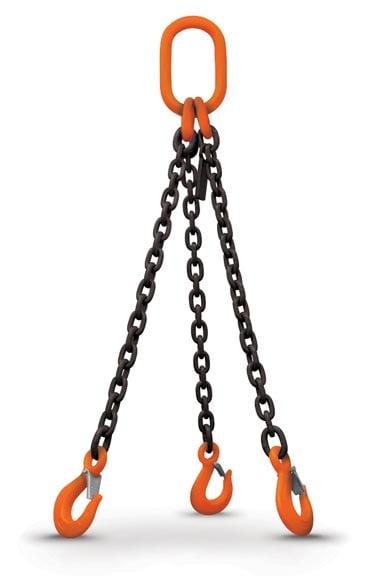Sling Selection & Working Load Limits: What You Need to Know
Everything You Need To Know About Lifting Slings
Rigging |
Safety and Training |
By Tim Lewis |
Mar 26, 2014

Chain slings are a combination of chain, hooks, rings and other attachments used primarily for overhead lifting applications. Slings are often used in conjunction with cranes and other lifting devices and allow riggers to create custom configurations to lift loads depending on the needs of that specific application.
Standard chain sling configurations consist of chain branches that are affixed on one end to a master link or ring with some type of attachment. When building a sling, ASME, NACM and OSHA recommend that only alloy steel chain is used. Columbus McKinnon’s Herc-Alloy chain, available in Grades 80 and 100, is made of superior triple alloy steel and is a strong and durable option for building chain slings.
All chain slings should come with a metal identification tag that is affixed to the chain. The tag should include the following information: sling size, reach, working load limit, serial number, manufacturer name, grade of sling and number of branches.
Proper Chain Sling Selection
When choosing a chain sling there are a few things to consider:
- Weight and configuration of the load(s) to be lifted
- Type of chain sling required, according to weight and configuration
- Size of the body chain according to the working load limits. Be sure to take into consideration the effect of the required angle (see information below).
- Reach required to give the desired angle. This is measured from the upper bearing surface of the master link to the bearing surface of the lower attachment.
- The share of load on pick points and location of the center of gravity
What Determines a Sling’s Working Load Limit?
The working load limit indicates the maximum load that should be applied to the sling and should never be exceeded during use to ensure operator safety.
Sling working load limits are determined by the following:
- Type of hitch
- Material strength
- Design factor
- Diameter of curvature (D/d)
- Angle of loading
The working load limit of a sling can also be affected by the conditions the sling is used in. For example, rapidly applying a load can produce dangerous overloading conditions. Also, the twisting and knotting of links or sling components can decrease a sling’s working load limit. Environmental conditions, such as elevated temperatures, can affect the working load limit of a sling as well.
Since slings are most often used at an angle, let’s review an example of how angle of loading affects a sling’s working load limit. In the diagram below, the percentages shown represent the maximum working load limit of the sling when used at the designated angle. In some instances the working load limit of the chain is reduced to 50%!
For example: One 3/8″ Grade 80 double sling used at 90˚ would have a working load limit of 2 times the working load of a 3/8″ Grade 80 single or 2 x 7, 100 lbs. = 14,200 lbs.
The same double sling used at 35º would have a maximum working load limit of 57% of 14,200 lbs. or .57 x 14,200 lbs. = 8,094 lbs.

For another example of how the angle of use can affect the working load limit of a chain sling, check out this past blog post: What is the working load limit of a 2 legged chain sling?
Want to learn more? View our Safety Webinar on Chain Sling Inspection
North America - EN







